Elk numbers up, deer and pronghorn still below hunting season averages
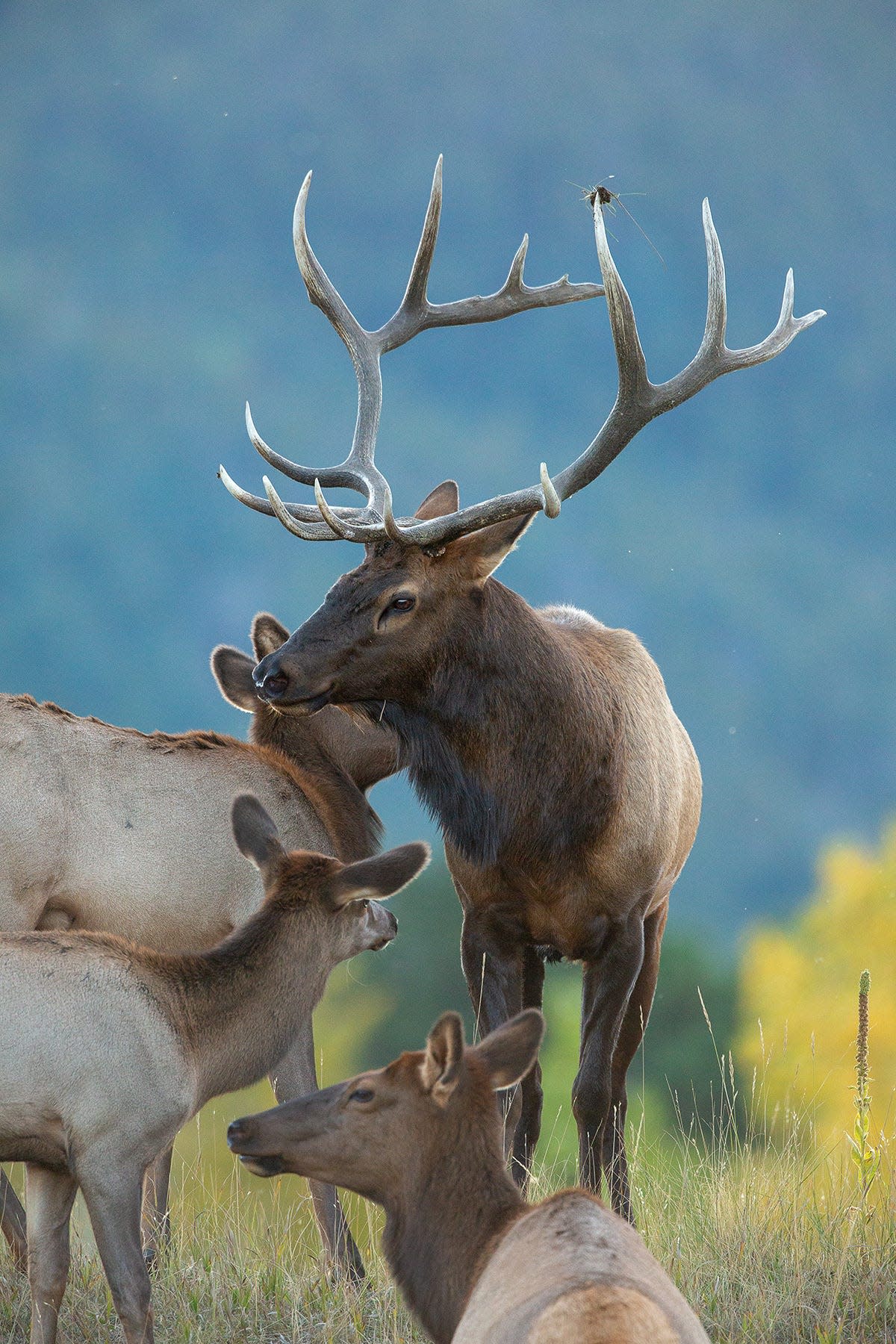
With archery and upland game bird hunting seasons scheduled to begin this weekend, the Montana Department of Fish, Wildlife and Parks (FWP) has released its 2023 Montana hunting forecast.
Increased winter and spring precipitation over the past year has eased the extreme drought conditions that impacted much of the state, improving wildlife habitat conditions across most of northcentral and northeastern Montana. However, many of the hunting districts continue to have below-average populations of deer and pronghorn.
At the same time favorable weather over the winter and spring have resulted in ideal habitat conditions for upland game birds in northcentral Montana, and the outlook for nest success looks promising for those birds lucky enough to survive the difficult conditions of past years.
What follows is a more detailed forecast of hunting conditions based upon FWP’s 2023 report.
Elk survival, production near normal
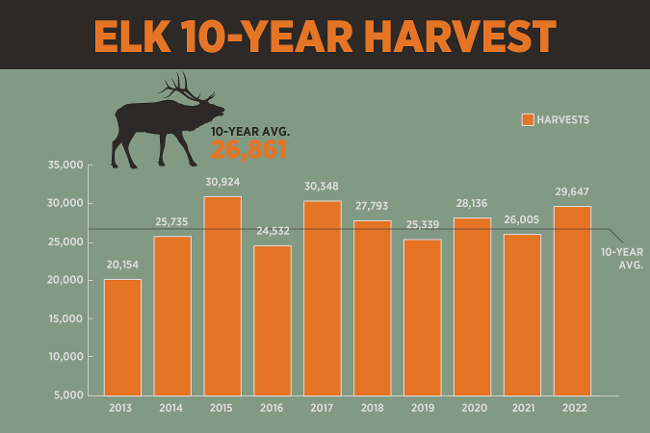
Hunters can look forward to good numbers of elk on the northcentral Montana landscape, since elk survival and calf production were near normal in the preceding year. This has led to an expectation of generally good elk hunting across much of Region 4 in the upcoming season.
“The southern Rocky Mountain Front continues to show overall stability for elk numbers compared to recent years,” FWP’s forecast reports. “The Sun River elk herd population remains near long-term average, with bull to cow numbers also near long-term average, although hunters rely heavily on snow and cold weather to move these elk into areas where they are accessible.
“Strong elk numbers persist along the northern Rocky Mountain Front. Elk numbers in the Sweetgrass Hills are significantly above long-term average. Elk numbers in the Little Belt and Highwood mountains appear to be stable.”
Hunters can look forward to good numbers of elk on the landscape across much of northcentral Montana in the upcoming season, since elk survival and calf production were near normal. The conditions have led to an expectation of generally good elk hunting.
FWP notes that elk distribution and accessibility on public land can often be highly weather dependent, and hunters should be aware that access to big game on private land can be difficult to obtain, so they should respectfully seek permission as early as possible to hunt those areas.
Mule deer on 'restrictive' season
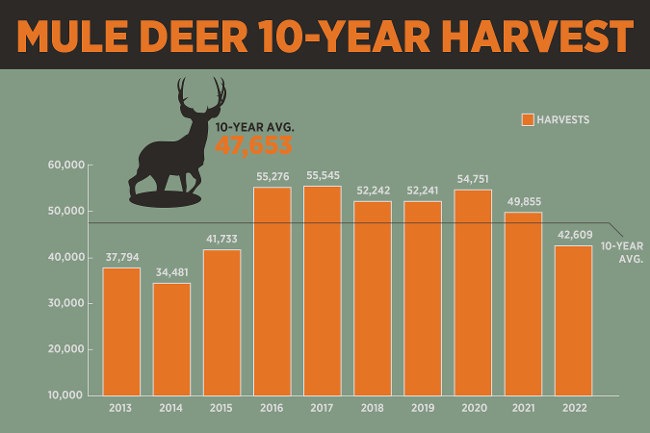
Aerial surveys in 17 of the 33 hunting districts in Region 4 have prompted FWP to implement a “restrictive” hunting season structure for mule deer across most of the Prairie Mountain Foothills. Antlered-buck-only hunting is allowed on the general license, and few or no antlerless B licenses will be available.
“Mule deer numbers along the northern Rocky Mountain Front are also below long-term average, as is also the case in the Sweetgrass Hills,” the FWP forecast states. “In better news though, both mule deer and mule deer buck numbers appear to be good this year in the Golden Triangle.
“The Missouri Breaks hunting districts of eastern Region 4 have seen significant declines in mule deer numbers due to harsh winters and extreme drought of past years. These areas are also in a “restrictive” hunting season structure for antlered bucks only, and hunters in eastern parts of Region 4 should expect to see noticeably lower mule deer numbers this fall. The Fish and Wildlife Commission approved an emergency measure this summer to change mule deer regulations from either-sex on the general license to antlered buck only in HDs 471, 426 and 419.
“Deer populations have improved in the Little Belts after several years of low numbers and are nearly back to average.”
Populations of Mule Deer vary widely across northeast Montana depending on the hunting district. Overall, numbers during spring surveys showed the region-wide population at 25 percent above long-term average, but 4 percent lower than 2022.
Mule deer populations remain above average in the eastern third of Region 6 as well as the areas north of Highway 2. In HDs 621 and 622 observed where mule deer populations were 70 percent below the long-term average, more restrictive measures have been put into place. Buck-only harvest and no B licenses will be valid in these districts. The 620-00 antlers mule deer B license will only be valid in HD 620 for the 2023 hunting season.
White-tailed deer provide opportunity
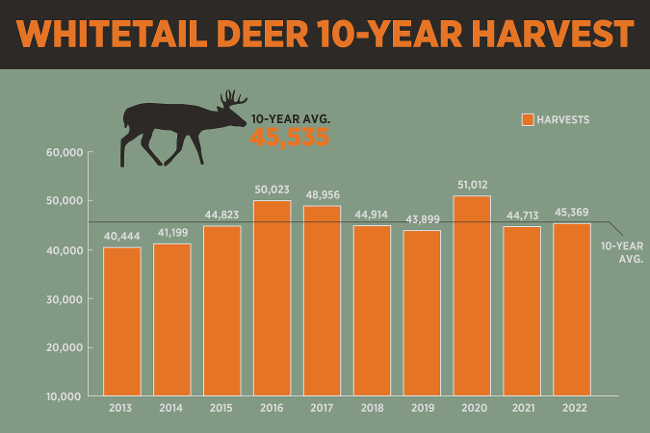
Biologists report that white-tailed deer numbers are generally good across much of Region 4, and should provide lots of hunting opportunities for both bucks and antlerless deer. Single region over-the-counter antlerless B license are available, and in some cases a second white-tailed B license may also be available to hunters. Whitetails are most prevalent in lower foothills and along rivers and streams on private land, so obtaining landowner permission early is important to a successful hunt.
FWP’s 2023 spring survey showed white-tailed deer density in northeastern Montana averages 6.2 deer per square mile, which is 40% below the long-term average of 10.4 deer per square mile, and 15 percent below 2022.
Although white-tail densities across the region remain lower, larger numbers remain in some areas of the far northeast corner and the western end of the region. Lower densities may mean that riparian areas have had time to recover.
Pronghorn population significantly reduced
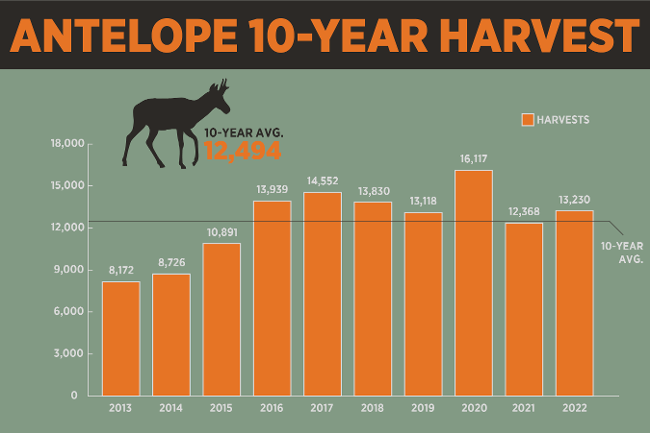
Late winter weather was particularly severe in the White Sulphur Springs area this year, which significantly reduced pronghorn overwinter survival and fawn recruitment. To allow those herds to recover, FWP has recommended reductions in both antlered buck and doe/fawn pronghorn licenses this fall.
Pronghorn numbers in the Golden Triangle area of north-central Montana are slightly below long-term average, but buck numbers appear to be up slightly. Further north in the Golden Triangle, pronghorn numbers have dipped, mainly due to a combination of past drought and prolonged cold and snowy weather this spring.
“FWP biologists found very high fawn recruitment in HD 430,” the FWP forecast states, “which bodes well for the future. But pronghorn licenses for both bucks and does were reduced in HD 470 after surveys showed noticeably lower numbers there.”
“In general, pronghorn populations have been slowly increasing during the past 12 years across the region from historic lows in 2011,” FWP’s forecast states. “While some survey areas have observed increased numbers and have been at or above their long-term averages, the recent drought and long winter have reduced numbers in some districts, and fawn ratios were below the long-term average in all districts. Buck ratios were near to above average in most districts.”
Those who have drawn licenses should still have a good opportunity to harvest an antelope.2023 upland game bird forecast.
2023 big game hunting seasons
Pronghorn: 900 series; Aug. 15 – Nov. 12 * Archery; Sep. 2 – Oct. 6 * General; Oct. 7 – Nov. 12
Bighorn Sheep: Archery; Sep. 2–Sep. 14 * General; Sep. 15 – Nov. 26
Bison: Nov. 15 – Feb. 15, 2024
Black Bear: Spring; April 15 – End dates vary * Archery; Sep. 2 – Sep. 14 * Fall; Sep. 15 – Nov. 26
Deer & Elk: Archery; Sep. 2–Oct. 15 * Youth, deer only; Oct. 19 – Oct. 20 * General; Oct. 21 – Nov. 26 * Backcountry – HDs 150, 280, 316 (HD 316 does not have an archery only season) * Archery; Sep. 2 – Sep. 14 * General; Sep. 15 – Nov. 26
Moose: Sep. 15 – Nov. 26
Mountain Goat: Sep. 15 –Nov. 26
Mountain Lion: Archery; Sep. 2 – Oct. 15 * Fall; Oct. 21 – Nov. 26 * Winter; Dec. 1 – Apr. 14, 2024
Upland game bird forecast
“Several years of severe drought coupled with harsh winters had taken a significant toll on upland bird populations in northcentral,” the FWP forecast states, “but 2023 saw a slightly wetter than average winter, with above-average spring precipitation and temperatures and few severe spring and summer storms.
“With more good habitat available, but with bird numbers still below long-term averages, hunters can expect to find that birds will be more dispersed throughout the landscape and in lower densities. Despite better quality habitat and higher nesting success, sharp-tailed grouse and sage-grouse numbers remain down from their historical average.”
Sharp-tailed grouse can be found in the grasslands intermixed with farmland and foothills throughout the region, tending to day-roost on the tops of hills and coulees with grass and forb cover typically averaging shin height. On windy days, they prefer to stay on the leeward side of the hill where they can rest out of the wind. Pheasants will generally be closer to riparian areas and farmlands.
Finding areas with grass that is knee-high or taller, mixed with shrubs and small draws near a food source (farmland/shrub berries) is a good place to start looking for roosters. Hungarian partridge thrive in all the above habitats but are more susceptible to extreme weather. Large patches of grass and CRP with draws or fields and shrubby cover near farmland are good areas to search for Huns.
The term mountain grouse in Montana refers to three different species: the dusky grouse, ruffed grouse and spruce grouse. Of the three, dusky and ruffed grouse make up the majority of the population in northcentral Montana. There is some overlap of habitat, but generally ruffed grouse tend to occupy riparian areas that have a mixture of shrubs, aspens and conifers in the lower elevations of the mountains. Dusky and spruce grouse tend to occupy areas with a combination of old and new growth conifers with low lying berries in the higher elevations.
“It will take more than just one year of favorable conditions in order for upland bird numbers to fully recover, and hunters should temper their expectations somewhat,” the FWP forecast predicts. “Contact Matt Strauch, Region 4 upland gamebird habitat specialist, at mstrauch@mt.gov or 406-454-5870, with any questions.”
To be successful, it will be important for hunters to understand the habitat requirements for their target species and seek the best quality habitat they can find.
So, while better habitat conditions and nesting success are a step in the right direction for upland bird hunters in 2023, it will take more than just one year of favorable conditions in order for upland bird numbers to fully recover, and hunters should temper their expectations somewhat. Contact Matt Strauch, Region 4 upland gamebird habitat specialist, at mstrauch@mt.gov or 406-454-5870, with any questions.
2023 Upland game bird seasons
Mountain Grouse: Sept. 1 – Jan. 1, 2024
Partridge: Sept. 1 – Jan. 1, 2024
Pheasant: Oct. 7 – Jan. 1, 2024
Sage Grouse: Sept. 1 – Sept. 30
Sharp-tailed Grouse: Sept. 1 – Jan. 1, 2024
Turkey: Spring; Apr. 15–May 31 * Fall; Sept. 1 – Jan. 1, 2024
In addition to the hunting forecast already provided, FWP provides online information about hunting access, including our popular Block Management Program, which provides hunting access to more than 7 million acres of private land.
This article originally appeared on Great Falls Tribune: Montana Fish, Wildlife and Parks' 2023 hunting season forecasts

